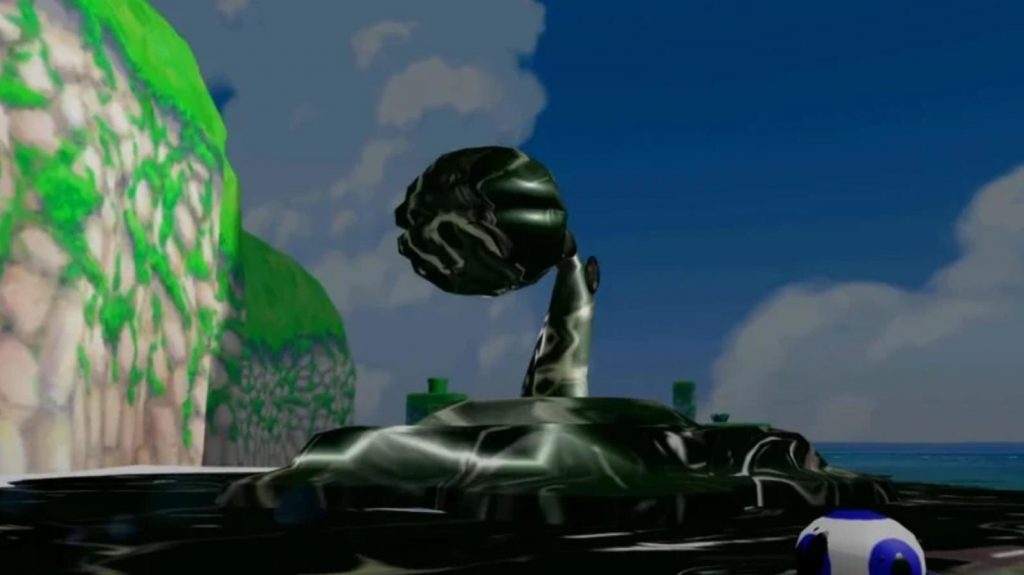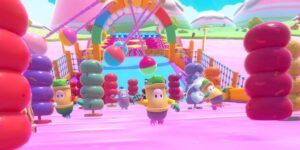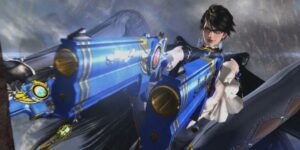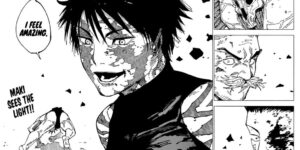With its random Yoshi appearances, sentient water pack, and overtly environmentalist story, Super Mario Sunshine is without a doubt one of Nintendo‘s weirdest titles. But something that rarely gets talked about is the game’s story, Sunshine’s premise – and the fact that it actually has one – was a particularly big departure from Nintendo’s usual platformers. Now, as the game turns 20 today, let’s celebrate one of the weirdest stories Nintendo has ever concocted.
Sunshine was originally meant to be a follow-up to the incredibly successful Super Mario 64, taking advantage of the far superior firepower of the Nintendo Gamecube. Nintendo not only dove headfirst into refining Mario’s 3D capabilities, but it also jumped straight into experimenting with gameplay. The ever-controversial FLUDD took Mario to new heights, and the interdimensional arcade-like levels played with space in new ways.
That gameplay experimentation also came with narrative experimentation. The game had a new tropical setting, extensive voice acting and cinematics, and level environments built around legendary creatures. The story went in all sorts of directions, resulting in a game-world that was, at parts, confusing. But as strange as Sunshine’s story was, it was a bold and exciting step towards discovering what the future of Mario stories could be.


There are few introductory cinematics that were as tonally strange as the introduction to Sunshine. After landing in a stunning tropical landscape, the island police quickly apprehend Mario for a series of coincidental environmental crimes (a classic case of ‘blame the outsider’). Mario enthusiasts were met with solemn existential monologues from FLUDD and morose court scenes – all a stark difference from the joyful tunes of Mario 64.
This surprisingly grim entry to this gorgeous new world was equal parts confusing and amusing; after all, it’s plain ridiculous to see a blank-faced Mario sitting unbothered in a jail cell. However, as bizarre as it was, it sets up a deeply important narrative thread for the rest of the game. In an unexpected move for Nintendo, Sunshine’s plot is undeniably a political tale. Don’t get me wrong – it’s as strange for me as it is for you having “Mario” with “political” in the same sentence. Nintendo markets these games as fun romps with castles and princesses and weird little mushroom guys! But in truth, it is nearly impossible to look at Sunshine without seeing its environmentalist themes.


Throughout the game, players clean up small ecological disasters, from giant Gooper Bloopers to paint-polluted piranha plants. Bowser Jr.’s magic paint may be gloopy and cartoony, but its design evokes footage of oil spilled on ocean water. Mario even has an oily disguise – a version of Mario that is as corrupted as the lands of Isle Delfino themselves.
As Mario single-handedly restores and preserves Isle Delfino for its apathetic residents, the game reflects the similarly apathetic attitude people have towards solving real-life climate issues. That is how Sunshine becomes a morality tale: it shows the impact direct action has on the environment, and teaches children the value of keeping the world around you clean.
All of this is to show how dramatic of a direction Sunshine’s story took. It was nothing like anything Nintendo had produced before, and it embraced ambitious themes like environmentalism in mechanically fun ways. You can argue over the effectiveness of Nintendo’s messaging, but their willingness to jump into political themes in Sunshine was nothing short of admirable.


Aside from its hefty themes, Sunshine was full of incredible creatures and environmental lore. Soaring birds made of sand, giant storming caterpillars, and humanoid piranha plants popped up left and right. Nintendo populated Isle Delfino with as many cool creatures as possible – even if their existence didn’t quite make sense.
As random as these different creatures might seem, they represent an ecstatic playfulness. The developers created an incredibly expansive world that tested different mechanics within each sub-location. Each creature was grand, expressive, and challenging, giving the player new things to interact with and discover. They experimented and played around with different ways to meld world lore with platformer abilities, resulting in some truly unique levels. Some, of course, were more successful than others, but it was this diversity of play that gave the game so much character.


Perhaps the weirdest aspect of Sunshine was its focus on Bowser and Bowser Jr. This was the first mainline game to really characterize Bowser Jr. beyond being a mini version of his father. While he had the same goals as Bowser, Bowser Jr. was a character that had his own motivations and methods for achieving those goals. The two only make appearances every now and then, but the real heart of their story comes in the game’s finale cinematic.
As Bowser and his son sit watching Isle Delfino from afar, the two share a surprising moment of emotional vulnerability. Bowser is honest about who Peach is, yet Bowser Jr. still supports his dad’s dream. As weird as the voice acting is, the moment is honest, heartfelt, and almost sweet.
Bowser Jr.: “Someday, when I’m bigger, I’m gonna fight that Mario again!”
Bowser: “That’s my boy! Well put, son!”
The Bowser father/son relationship is wholly unexpected, yet it adds so much character to the story’s villains. They’re not just scary evil spikey guys – Bowser Jr. is just a kid looking for someone to be his mom. He and Bowser have a surprisingly supportive relationship, and it reveals an entirely new side to the infamous villains. It humanizes them, and it’s one of the few Mario games that do.
While players don’t necessarily chase after Mario platformers to have their heartstrings pulled, Sunshine took the opportunity to create multidimensional villains. It’s funny, it’s cute, and it’s interesting, making the game’s portrayal of its villains truly unique.


Sunshine was a weird and wild direction for Nintendo. But, looking at its mishmash of elements, it’s clear that Sunshine is a testament to experimentation. It embraced the weird that came with ambitious designs and mechanics, jumping from new element to new element with pure joy.
That is what makes Sunshine such a memorable game. That joy, that unabashed strangeness, that curiosity to try new things. It’s baked into its essence, encouraging players to jump into this wacky world with as much fun as the designers themselves seemed to have had. While Sunshine’s story may not have the most elegant worldbuilding, its love for experimentation is certainly something that deserves to be celebrated – even 20 years later.
- amazon prime gaming
- axie infinity
- Casino Games
- coingenius
- Dualshokers
- EA Sports
- Evil Geniuses
- Gaming
- gaming headset
- gaming pc
- madden nfl
- Nintendo
- Online casino games
- Originals
- pc games
- plato
- plato ai
- plato data intelligence
- plato game
- plato gaming
- platodata
- platogaming
- playstation
- prime gaming
- Super Mario Sunshine
- Team SoloMid
- xbox
- zephyrnet











